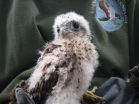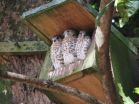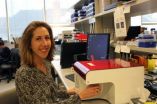(Press-News.org) The widespread loss of forest to sugarcane fields on the island of Mauritius has forced kestrels living there to survive by speeding up their life histories, according to a report published online on February 20 in the Cell Press journal Current Biology. By getting an earlier start, the birds are managing to have just as many offspring, even though they die sooner.
Those changes to the kestrels' life history are apparently driven entirely by their early life experiences, the researchers say.
"This adaptive, plastic response is a testament to how resilient this species is," says Samantha Cartwright, a postdoctoral researcher from the University of Reading and lead author on the study. "It has narrowly avoided extinction in the 20th century and is now persisting in a landscape very different from what it would have originally evolved to occupy."
The kestrels' future remains in doubt, given that less than two percent of the native forest that once covered Mauritius remains today. Kestrels already can't live at all on many parts of the island, most of which has been converted to agricultural land.
In 1974, Mauritius kestrels were labeled "the rarest birds in the world," with only four individuals living in the wild. They are now the most intensively monitored wild tropical raptors in the world, which made them a good case study for questions about the effects of habitat change.
The researchers analyzed 23 years of longitudinal data on the Mauritius kestrel to find that females born in territories affected by habitat change shifted investment in reproduction to earlier in life at the expense of late life performance. They also had lower survival rates as young adults.
"We found that birds from both types of habitat still ultimately produce the same number of offspring in a lifetime," Cartwright says. "The strategy is a good one: breeding when younger compensates for the increased risk of dying sooner."
While the birds may be making it for now, Cartwright emphasizes that their shifted life history should serve as a warning about the extent to which human activities have already influenced wild species.
"Taken together, our results suggest that human activities can have a persistent effect on the life histories of wild organisms through natal environmental effects," the researchers write. "Given the ubiquity of human-induced habitat change, the patterns we report could be widespread but remain poorly documented due to the short-term nature of most studies that attempt to quantify only the immediate impact of habitat change on fitness traits."
INFORMATION:
Current Biology, Cartwright et al.: "Anthropogenic natal environmental effects on life histories in a wild bird population."
Mauritius kestrels show long-term legacy of man-made habitat change
2014-02-20
ELSE PRESS RELEASES FROM THIS DATE:
CHOP researcher co-leads study finding genes that affect blood pressure
2014-02-20
A large international study analyzing genes in tens of thousands of individuals has discovered 11 new genetic signals associated with blood pressure levels. Ten of those signals are in or very near genes encoding proteins that appear to be likely targets for drugs already in existence or in development.
"The fact that most of these new gene signals are 'druggable' targets offers the possibility of expedited pharmaceutical development of therapeutics for high blood pressure, a serious risk factor for cardiovascular diseases," said geneticist Brendan J. Keating, D. Phil., ...
Molecular 'cocktail' transforms skin cells into beating heart cells
2014-02-20
SAN FRANCISCO, CA—February 20, 2014—The power of regenerative medicine appears to have turned science fiction into scientific reality—by allowing scientists to transform skin cells into cells that closely resemble beating heart cells. However, the methods required are complex, and the transformation is often incomplete. But now, scientists at the Gladstone Institutes have devised a new method that allows for the more efficient—and, importantly, more complete—reprogramming of skin cells into cells that are virtually indistinguishable from heart muscle cells. These findings, ...
Scientists find resistance mechanism that could impact antibiotic drug development
2014-02-20
JUPITER, FL, February 20, 2014 – The use of antibiotics is often considered among the most important advances in the treatment of human disease. Unfortunately, though, bacteria are finding ways to make a comeback. According to the Centers for Disease Control, more than two million people come down with antibiotic-resistant infections annually, and at least 23,000 die because their treatment can't stop the infection. In addition, the pipeline for new antibiotics has grown dangerously thin.
Now, a new study by scientists from the Florida campus of The Scripps Research ...
Chemical chaperones have helped proteins do their jobs for billions of years
2014-02-20
ANN ARBOR—An ancient chemical, present for billions of years, appears to have helped proteins function properly since time immemorial.
Proteins are the body's workhorses, and like horses they often work in teams. There exists a modern day team of multiple chaperone proteins that help other proteins fold into the complex 3D shapes they must achieve to function. This is necessary to avert many serious diseases caused when proteins misbehave.
But what happened before this team of chaperones was formed? How did the primordial cells that were the ancestors of modern life ...
Scientists discover 11 new genes affecting blood pressure
2014-02-20
New research from Queen Mary University of London has discovered 11 new DNA sequence variants in genes influencing high blood pressure and heart disease.
Identifying the new genes contributes to our growing understanding of the biology of blood pressure and, researchers believe, will eventually influence the development of new treatments. More immediately the study highlights opportunities to investigate the use of existing drugs for cardiovascular diseases.
The large international study, published today in the American Journal of Human Genetics, examined the DNA ...
A changing view of bone marrow cells
2014-02-20
In the battle against infection, immune cells are the body's offense and defense—some cells go on the attack while others block invading pathogens. It has long been known that a population of blood stem cells that resides in the bone marrow generates all of these immune cells. But most scientists have believed that blood stem cells participate in battles against infection in a delayed way, replenishing immune cells on the front line only after they become depleted.
Now, using a novel microfluidic technique, researchers at Caltech have shown that these stem cells might ...
Compound improves cardiac function in mice with genetic heart defect, MU study finds
2014-02-20
COLUMBIA, Mo. — Congenital heart disease is the most common form of birth defect, affecting one out of every 125 babies, according to the National Institutes of Health. Researchers from the University of Missouri recently found success using a drug to treat laboratory mice with one form of congenital heart disease, hypertrophic cardiomyopathy — a weakening of the heart caused by abnormally thick muscle. By suppressing a faulty protein, the researchers reduced the thickness of the mice's heart muscles and improved their cardiac functioning.
Maike Krenz, M.D., has been ...
Turning back the clock on aging muscles?
2014-02-20
A study co-published in Nature Medicine this week by University of Toronto researcher Penney Gilbert has determined a stem cell based method for restoring strength to damaged skeletal muscles of the elderly.
Skeletal muscles are some of the most important muscles in the body, supporting functions such as sitting, standing, blinking and swallowing. In aging individuals, the function of these muscles significantly decreases.
"You lose fifteen percent of muscle mass every single year after the age of 75, a trend that is irreversible," cites Gilbert, Assistant Professor ...
Researchers say distant quasars could close a loophole in quantum mechanics
2014-02-20
In a paper published this week in the journal Physical Review Letters, MIT researchers propose an experiment that may close the last major loophole of Bell's inequality — a 50-year-old theorem that, if violated by experiments, would mean that our universe is based not on the textbook laws of classical physics, but on the less-tangible probabilities of quantum mechanics.
Such a quantum view would allow for seemingly counterintuitive phenomena such as entanglement, in which the measurement of one particle instantly affects another, even if those entangled particles are ...
Crop species may be more vulnerable to climate change than we thought
2014-02-20
A new study by a Wits University scientist has overturned a long-standing hypothesis about plant speciation (the formation of new and distinct species in the course of evolution), suggesting that agricultural crops could be more vulnerable to climate change than was previously thought.
Unlike humans and most other animals, plants can tolerate multiple copies of their genes – in fact some plants, called polyploids, can have more than 50 duplicates of their genomes in every cell. Scientists used to think that these extra genomes helped polyploids survive in new and extreme ...







